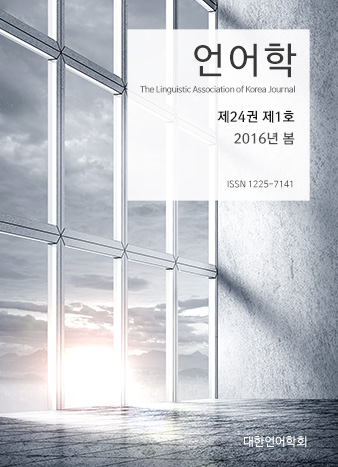대한언어학회 전자저널

Abstract
Kang, Sung-Kwan. (2016). Development of teaching and learning models and analyses of learning achievement in extensive reading. The Linguistic Association of Korea Journal 24(1), 131-150. The purpose of the study is to prove efficiency of extensive reading with two suggested teaching and learning models and present analyses of learning achievement. Two groups were selected; the 1st group of 20 college students focusing on word-definition-and-grammar and 2nd group of 20 focusing on following-events-and-the-story-line in the story. After the applications of the models for the study, each group was given an achievement test of the five sections; Setting, Character, Dialogue, Plot and Vocabulary. The 2nd group achieved higher score in the average of the five sections. More specifically, the scores of the 2nd in Character, Dialogue, and Plot were statistically higher. However, the 1st group showed higher achievement in Vocabulary. Both groups did not show significant difference in Setting. Noticeably, the 2nd model showed more efficiency of learning in the study. On the basis of the findings, developing some teaching and learning models in extensive reading is necessary to benefit English learners.
Keywords
# 다독(extensive reading) # 집중적 읽기(intensive reading) # 교수·학습 모형(teaching and learning model)
References
- 변지현. (2011). 중등 영어교사들의 다독 체험이 읽기 동기 부여 및 자신감 형성에 미치는 영향. 영어교과교육, 10(1), 119-144.
- 안희성, 임병빈, 윤상돈. (2010). 다독이 중학생의 영어 쓰기 능력이 미치는 연구. 영어교과교육, 9(3), 227-249.
- 조경희, 이정원. (2010). 확장형 읽기를 통한 고등학교에서의 영어 읽기 교육. 영어교육, 65(4), 343-371.
- 최성희. (2010). 중등 영어 학습자를 위한 다독 읽기 활동의 효용성 탐구. 영어어문교육, 16(3), 365-395.
- Cha, J. E. (2009). The effect of extensive reading on enhancing vocational high school students’ L2 vocabulary & reading rates. English Teaching, 64(3), 3-30.
- Choi, J. E. (2011). Enhancing EFL learner’s communicative competence through extensive reading of children’s literature. Education of British and American Literature, 15(1), 145-173.
- Day, R. R., & Bamford, J. (1998). Extensive reading in the second language classroom. Cambridge: Cambridge University Press.
- Elley, W. B. (1991). Acquiring literacy in a second language. Language Learning, 41(3), 375-411.
- Geoffrey, B. (1980). Teaching English as a foreign language. London: Routledge & Kegan Paul.
- Grabe, W. (1986). The transition from theory to practice in teaching reading. In F. Dubin, D. E. Eskey, & W. Grabe(Eds.), Teaching second language reading for academic purposes, (22-48). Reading, MA: Addison Wesley.
- Hafiz, F. M., & Tudor, I. (1989). Extensive reading and the development of language skills. ELT Journal, 43(1), 4-13.
- Hafiz, F. M., & Tudor, I. (1990). Graded readers as an input medium in L2 learning. System, 18(1), 31-42.
- Heo, S. Y. (2012). A study on the initial stage of extensive reading process through college students’ journal writing. English Language & Literature Teaching, 18(3), 77-92.
- Jacobs, W, W. (1989). The monkey’s paw. Oxford: Oxford University Press.
- Jeon, J. M. (2008). Extensive reading in a formal English reading class. English Teaching, 63(4), 49-83.
- Krashen, S. D. (1985). The input hypothesis: Issues and implications. New York: Longman.
- Lai, F. K. (1993a). Effect of extensive reading on English learning in Hong Kong. CHUK (Chinese University of Hong Kong) Education Journal, 21(1), 23-36.
- Lai, F. K. (1993b). Effect of a summer reading course on reading and writing skills. System, 21(1), 87-100.
- Lee, Y. S., & Kim, K. J. (2011). Extensive reading of EFL elementary school students. English Language Teaching, 23(3), 41-59.
- New York City Board of Education. (1948). Syllabus of minima in modern foreign languages: Classroom technic in reading. In M. Newmark, Twentieth century modern language teaching: Sources and readings, (299-302). New York: Philosophical Library.
- O, K. M. (2011). An extensive reading study in university English classes. English Language and Linguistics, 17(1), 133-165.
- Palmer, H. E. (1964). The principles of language-study. Oxford: Oxford University Press.
- Palmer, H. E. (1968). The scientific study and teaching of languages. Oxford: Oxford University Press.
- Report of the committee of Twelve of the Modern Language Association of America(1948): A critical review of methods of teaching. In M. Newmark(Ed.), Twentieth century modern language teaching: Sources and readings, (281-294).
- Richards, J. C. Platt, J., & Platt, H. (2nd ed.). (1992). Longman dictionary of language teaching and applied linguistics. Harlow, Essex: Longman.
- Shin, I. K., & Ahn, B. K. (2006). The effects of different types of extensive reading materials on reading amount, attitude, and motivation. English Teaching, 61(1), 67-88.
- Shin, K. C. (2003). Vocabulary acquisition through extensive reading in EFL class. Modern English Education, 4(2), 3-16.
- Simensen, A. M. (1987). Adapted readers: How are they adapted? Reading in a foreign Language, 4(1), 41-57.
- Tudor, I., & Hafiz, F. M. (1990). Graded readers as an input medium in L2 learning. System, 18(1), 31-42.
- West, M. (1955). Learning to read a foreign language and other essays on language-teaching (2nd ed.). London: Longman, Green.
- Yang, E. M. (2010). A study on the effectiveness of extensive reading in college English classes. English Language & Literature Teaching, 16(2), 169-188.